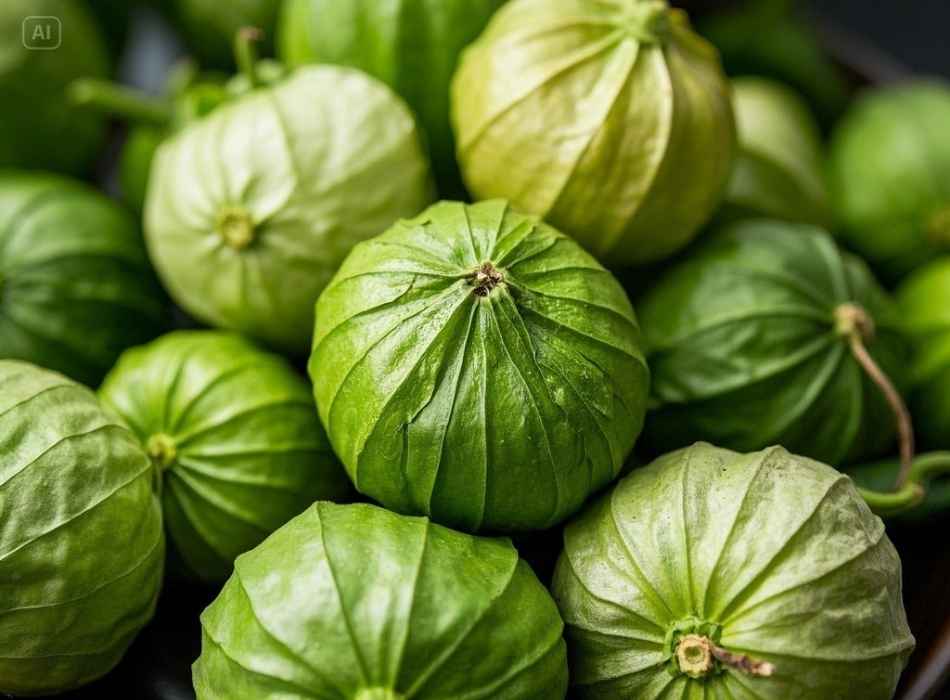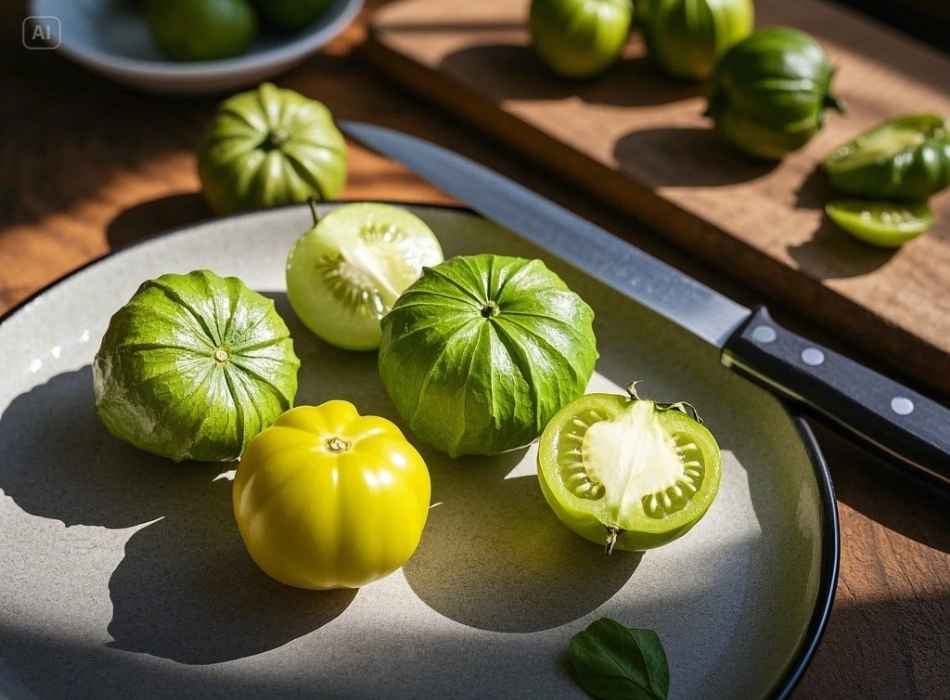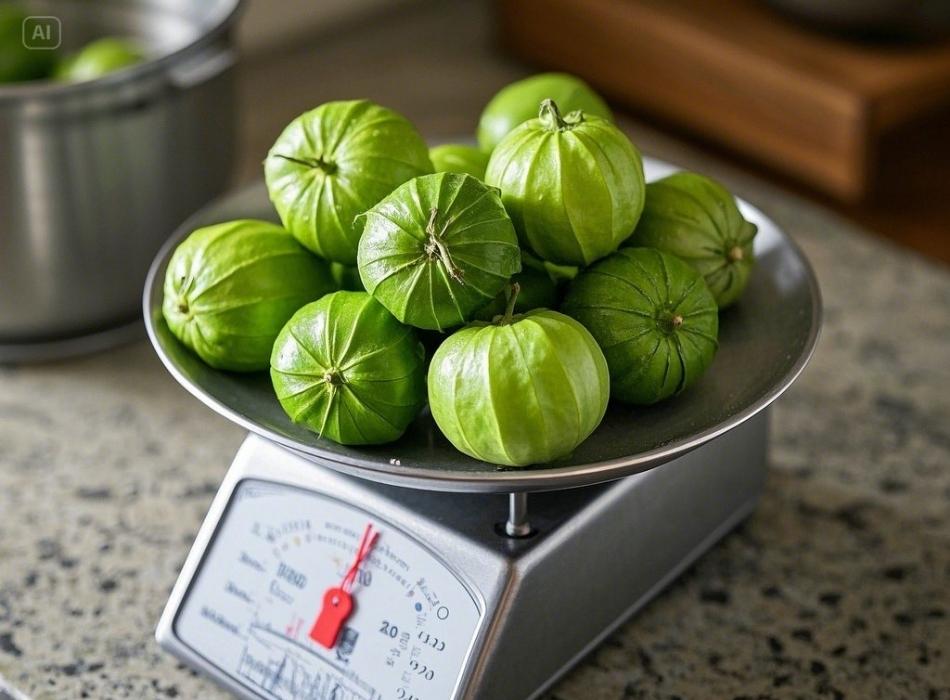Tomatillos are a staple in many Mexican dishes, known for their tart flavor that enhances salsas, sauces, and stews. If you’ve come across a recipe calling for tomatillos by weight, you might be wondering how many tomatillos you actually need to make up a pound. Whether you’re a seasoned home cook, a lover of Mexican cuisine, or a gardening enthusiast who just harvested fresh tomatillos, understanding how many tomatillos are in a pound can make meal prep a lot easier.
This guide will help you confidently measure and use tomatillos in your cooking, offer tips for selecting the best ones, and provide ideas for incorporating them into your meals.
What Are Tomatillos?
Before we get into measuring, let’s clarify what tomatillos are. Often mistaken for unripe green tomatoes, tomatillos (scientific name Physalis philadelphica) is a type of fruit encased in a papery husk. These small, green fruits are a key ingredient in Mexican cuisine, lending their tangy flavor to dishes like salsa verde and enchiladas verdes.
The texture is firm, and the flavor balances a bright tartness with subtle sweetness, making them versatile in both raw and cooked applications.
How Many Tomatillos Make Up a Pound?

The number of tomatillos in a pound depends on their size, as they can vary significantly. Here’s a quick breakdown based on typical sizes you’ll find at a grocery store or in your garden:
- Small tomatillos (1-2 inches in diameter): Around 15-20 tomatillos make up a pound.
- Medium tomatillos (2-2.5 inches in diameter): About 10-12 tomatillos equal one pound.
- Large tomatillos (3+ inches in diameter): You’ll need about 8-10 tomatillos to reach a pound.
Keep in mind that these are just estimates, and the actual number of tomatillos in a pound may vary slightly. Additionally, the weight of a pound can also be affected by factors such as moisture content and packing density.
Different Ways to Measure Tomatillos
There are several ways to measure tomatillos, depending on how they will be used in the recipe or dish. Here are three common methods for measuring tomatillos:
- By count: This method involves counting each tomatillo. It’s typically used when the size of the produce is important, such as for stuffed or grilled tomatillos.
- By weight: Measuring by weight is more accurate and precise than counting. This method is usually used for salsas, sauces, and soups, where the exact amount of tomatillos is important for the flavor and consistency of the dish.
- By volume: Measuring by volume is a good option when precise measurements are not crucial. This method is often used in cooking rather than baking, where slight variations in ingredients won’t affect the outcome as much.
Each of these methods has its pros and cons. The best approach will depend on your personal preference, as well as factors such as the availability of tools (e.g., kitchen scale) and time constraints.
If you’re unsure about the size or don’t have a kitchen scale to confirm, start with more tomatillos than the recipe calls for to avoid running short.
How to Select Fresh Tomatillos

When shopping for or harvesting tomatillos, quality matters. Here’s how to choose the best ones for your recipes:
- Look for bright green skin: Tomatillos should be vibrant in color, as this indicates ripeness and optimal flavor. Avoid any that appear dull or yellowing.
- Inspect the husk: The papery husk should be intact and light brown. It should fit snugly over the fruit but feel dry, not damp.
- Feel for firmness: A ripe tomatillo should feel firm but have a slight give when pressed. Overly soft tomatillos may be past their prime.
- Check the weight: Heavier tomatillos are often juicier and fresher, while lighter ones may be dried out.
- Look for cracks or blemishes: Avoid tomatillos with any visible damage, as they may spoil more quickly.
- Smell the stem end: A fresh tomatillo should have a sweet, slightly tangy smell at the stem end. If it has no smell or smells sour, it may be overripe.
- Store properly: Tomatillos can be stored in a paper bag in the refrigerator for up to two weeks. Do not store them in plastic bags, as this can trap moisture and cause them to spoil faster.
- Prep and cook: To prep tomatillos, remove the husk and rinse off any sticky residue under cold water. They can be eaten raw or cooked in a variety of dishes, such as salsas, soups, and stews. For cooking, chop them up and add them to your dish towards the end of cooking to retain their texture and flavor.
- Versatility in the kitchen: Tomatillos may not be as commonly used as tomatoes, but they are just as versatile in the kitchen. They can be roasted, grilled, sautéed, or even pickled for a unique tangy twist on traditional recipes.
- Nutritional benefits: Tomatillos are not only delicious, but they also offer a range of health benefits. They are low in calories and fat, making them a great addition to any diet. They are also high in fiber, vitamin C, and antioxidants, all of which contribute to good overall health.
- Garden favorites: Tomatillos grow well in home gardens and can even thrive in container gardens. They require full sun and well-drained soil, making them easy to maintain for gardeners of all levels.
- Preserving the harvest: If you find yourself with an abundance of tomatillos from your garden or local market, don’t let them go to waste!
Shopping tip: Peel back the husk slightly to check for blemishes or discolorations before finalizing your choice.
Tips for Preparing Tomatillos

Tomatillos are easy to prepare, but they do require a few steps before use. Here’s a straightforward process to get them recipe-ready:
- Remove the husk: Peel the papery husk from the fruit and discard it.
- Rinse off the sticky residue: Tomatillos have a naturally sticky coating on their skin. Rinse them thoroughly under cold water to remove them.
- Chop or leave whole: Depending on your recipe, you can either chop the tomatillos into slices or quarters or leave them whole if roasting or boiling.
- Remove the seeds: The seeds of tomatillos are edible but can add a slight bitterness to your dish. To remove them, slice the fruit in half and scoop out the clusters of seeds with a spoon.
- Cook as desired: Tomatillos can be eaten raw, roasted, boiled, or sautéed – it all depends on your preference and recipe!
Pro tip: If you’re roasting or grilling tomatillos, leave them whole with just a few small slits in the skin. This prevents them from bursting and helps seal in their juices.
Using Tomatillos in Your Cooking
Now that you know how many tomatillos you need and how to prepare them, it’s time to put them to use! Here are a few popular and easy ways to cook with tomatillos:
1. Salsa Verde
Tomatillos are best known for their role in salsa verde. Roast or boil them, then blend with garlic, onion, jalapeño, cilantro, and lime juice for a tangy, versatile salsa that pairs perfectly with tacos, grilled meats, or tortilla chips.
2. Enchiladas Verdes
Roasted tomatillos make the base for a robust green sauce that coats enchiladas stuffed with chicken, cheese, or vegetables.
3. Green Pozole
Add cooked tomatillos to this traditional Mexican soup, made with hominy, pork, or chicken, and a blend of green chiles and spices.
4. Tomatillo Soup
A creamy, comforting soup made with tomatillos, chicken broth, and fresh herbs is a great way to showcase their bright acidity.
5. Grilled or Roasted Tomatillos
Whole roasted tomatillos make a great accompaniment to grilled fish or charred vegetables. They caramelize beautifully when cooked, bringing out a natural sweetness. Toss them in olive oil, salt, and pepper, and grill or roast until tender.
6. Tomatillo Salsa
Salsa verde, or green salsa, is a staple in Mexican cuisine and is made with tomatillos as its base. Blend roasted tomatillos with jalapeños, cilantro, onion, and lime juice for a tangy and flavorful sauce that pairs well with tacos, chips, or any grilled meat.
7. Tomatillo Guacamole
For a twist on the classic guacamole recipe, add some chopped tomatillos for an extra kick of acidity and texture. The combination of creamy avocados and tangy tomatillos creates a unique and delicious dip that is perfect for parties or as a topping for your favorite Mexican dishes.
8. Tomatillo Gazpacho
Gazpacho is a cold soup traditionally made with tomato, cucumber, peppers, and other vegetables. Adding tomatillos to the mix gives it a refreshing twist and adds complexity to the flavor profile. Blend all the ingredients with some bread for thickness, chill in the fridge, and serve on a hot summer day for a refreshing meal.
9. Tomatillo Jam
While tomatillos are often used in savory dishes, they can also be transformed into a delicious sweet jam. Combine tomatillos with sugar, lemon juice, and spices like cinnamon or cardamom in a pot and let it simmer until thickened. This jam is perfect for spreading on toast or adding to yogurt for breakfast.
10. Tomatillo Salsa
One of the most popular uses of tomatillos in Mexican cuisine is salsa verde. This tangy and slightly spicy sauce can be used as a dip for chips, topping for tacos or enchiladas, or mixed into soups and stews for added flavor. It’s easy to make by blending tomatillos, jalapeños, onion, garlic, cilantro, and lime juice. Adjust the heat level by adding more or less jalapeños, and feel free to experiment with other ingredients like avocado or pineapple for a unique twist on this classic recipe.
11. Tomatillo Guacamole
Speaking of avocados, tomatillos can also be used in guacamole for a tangy and refreshing flavor. Roast or boil the tomatillos until soft, then mash them together with avocados, onion, garlic, cilantro, lime juice, and any other desired ingredients like diced tomatoes or hot sauce. Serve with tortilla chips as an appetizer, or use it as a spread on sandwiches for a tasty lunch option.
Storing and Preserving Tomatillos
If you’ve got extra tomatillos from your garden or store run, here’s how to ensure they last as long as possible:
- On the counter: Fresh tomatillos with husks can be stored at room temperature for about a week.
- Refrigerator storage: For longer storage, remove the husk and store tomatillos in a paper bag in the crisper drawer; they’ll keep for 2-3 weeks.
- Freezing: Rinse and dry tomatillos, then freeze them whole, sliced, or puréed in a sealed bag for up to 6 months. Frozen tomatillos work great in cooked recipes.
- Washing before storage: It is best to wait until right before using them to wash your tomatillos. Washing them too soon can cause them to spoil faster.
- Visual inspection: Before storing, make sure to inspect each tomatillo for any signs of bruising or rotting. Discard any that appear damaged.
- Separate from other produce: Keep your tomatillos separate from other fruits and vegetables in the fridge. The ethylene gas produced by some fruits can cause them to ripen and spoil quickly.
Preservation tip: If you love canning, try making a large batch of salsa verde and canning it for future use!
Grow Your Tomatillos
For gardening enthusiasts, growing your tomatillos is both rewarding and surprisingly easy. They thrive in warm climates and require similar care to tomatoes. A single plant can yield several pounds of fruit, ensuring more than enough for your kitchen experiments.
Need a quick-growing guide? Here are a few essentials:
- Plant in pairs for pollination.
- Choose a sunny spot with well-drained soil.
- Harvest when the husk is dry and begins to split.
Freshly harvested tomatillos from your garden are unbeatable in flavor and quality!
Frequently Asked Questions
1. How long does it take for tomatillos to grow?
Tomatillos typically take about 75 to 100 days from planting to harvest, depending on the variety and growing conditions.
2. Do I need more than one tomatillo plant?
Yes, tomatillos require cross-pollination to produce fruit, so it’s essential to plant at least two plants close to each other.
3. When is the right time to harvest tomatillos?
Tomatillos are ready to harvest when their papery husks turn dry and begin to split open, and the fruit fills the husk.
4. Can tomatillos grow in containers?
Yes, tomatillos can thrive in large containers as long as they have plenty of sun, well-drained soil, and support for their sprawling growth. Ensure the container is at least 5 gallons in size.
5. How do I store freshly picked tomatillos?
Tomatillos can be stored in their husks in a cool, dry place for up to two weeks. For longer storage, you can remove the husks, wash the fruit, and freeze them.
Final Thoughts on Measuring Tomatillos
Whether you’re perfecting your salsa recipe or experimenting with a new tomatillo-based dish, understanding how many tomatillos make up a pound allows you to cook with confidence. Use these tips to select, prep, and incorporate these versatile fruits into your meals, and don’t forget to experiment with their unique tangy flavor!
Do you have a favorite tomatillo recipe or trick for choosing the best ones? Share it in the comments below!



















